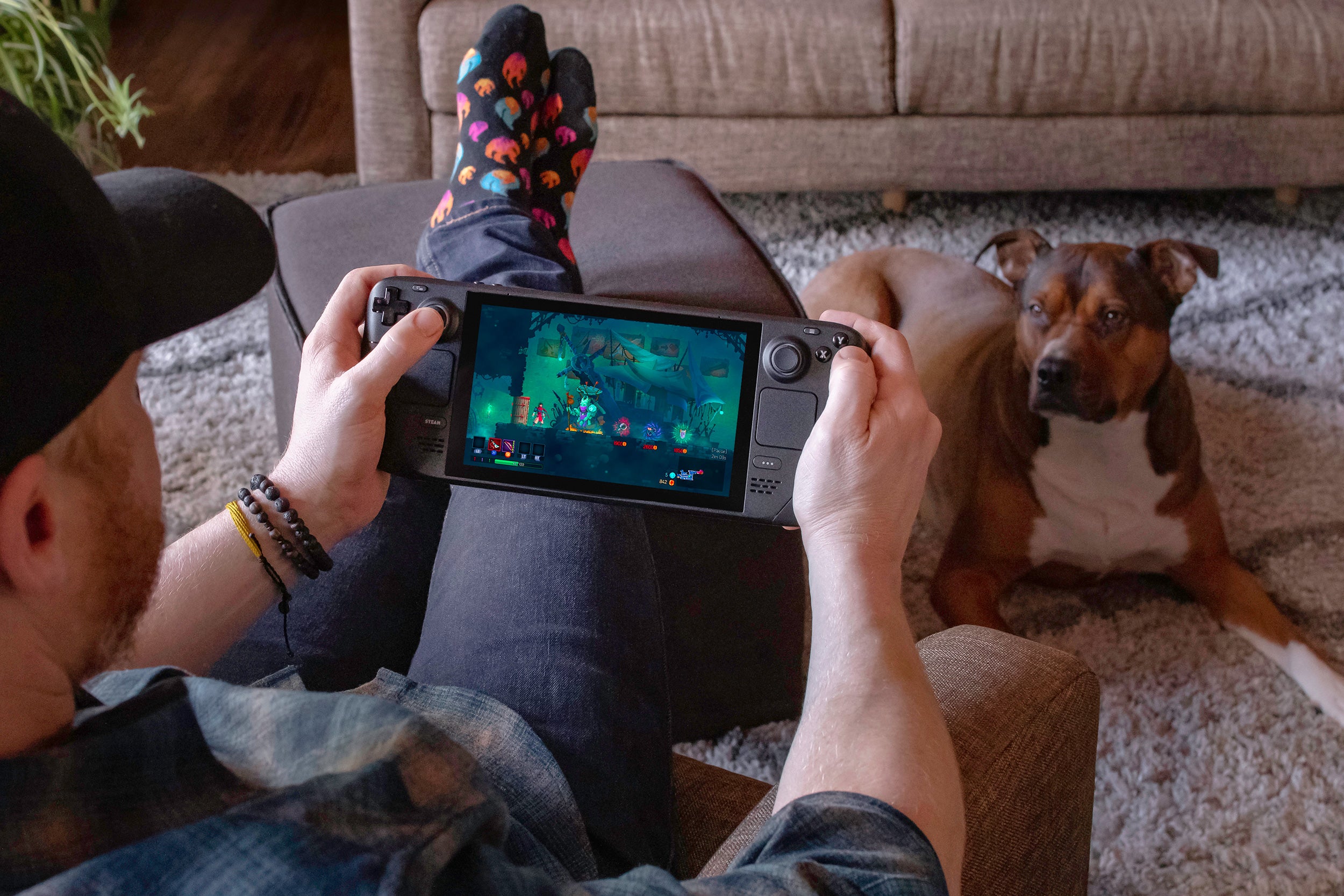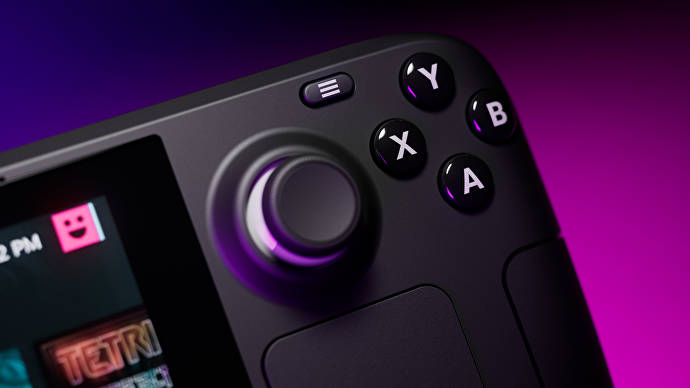Steam Deck review: it’s a chunky marvel, brimming with potential… when it works right
“Jesus Christ, that’s massive,” my partner exclaims. She’s walked in the room and is eyeing the unwieldy, heavy thing I’m gripping with both hands. And she’s right. The thing in question is the Steam Deck – and it is massive. Enormous. After using this, going back to a Nintnedo Switch feels like holding a tiny, dainty baby bird. It’s bonkers.
My extremely patient, long-suffering partner sees a lot of gaming hardware come through the doors of this house, but she’s never commented on the sheer size of a device before; not when I first unboxed the could-bludgeon-a-man sized new-generation consoles and not even as I rolled a 150kg arcade machine into the dining room unannounced. So her saying this does leave an impression: the Steam Deck is huge. And yet, it also feels small – because the amount of power it packs in still feels very, very impressive for the size of the machine.
Valve’s Steam Deck, a handheld gaming PC that’s basically a mid-tier gaming laptop in an outsized version of the Nintendo Switch form factor, is a technical marvel. It’s difficult to believe that it works – and it doesn’t always – but when it does, it’s truly incredible.
Across the internet, you’re today going to be able to read a lot of reviews that dive deep into the technical aspects of Steam Deck, tearing it down, heavily benchmarking it, and generally pulling the machine to pieces. Some of that coverage has been out for a while, in fact – I recommend the hardware review from the excellent GamesNexus, if you want that.
However, in the run-up to launch the Steam Deck has been ‘coming in hot’, to be charitable. Throughout the review period there’s been updates almost daily, tweaking and improving software and even adding all-new features. I’ve watched the number of ‘Great on Deck’ verified games balloon over the weeks, and the machine has genuinely been in a near-constant state of flux, affecting everything from menu flow to game performance. As such, it feels unwise to write a hardware review full of benchmarks and numbers that, next week, might no longer be accurate.
As a result, here on VG247 I wanted to do something a little different: a qualitative review. Like, what does the Steam Deck feel like to live with for a month?
In that time, I’ve used Steam Deck largely as Valve intended. I’ve played it on the sofa, in the bathroom, and during a hotel stay. I’ve sat and played it in the car while waiting to pick someone up. When friends came over for the Superbowl, a few of them toyed with it, installing and booting games, marveling at the performance and its simplicity. In the name of that simplicity, I’ve largely stuck to Valve’s official software, rather than installing Windows or other third-party solutions onto the Deck. I didn’t want to compromise their vision – because, honestly, that’s what most people set to buy it will likely do.
For my money, that’s the real power of the Steam Deck. This is a relatively cheap (starting at £359/$399) PC gaming device, which is lovely, but it also aims to be as plug-and-play as consoles. In the best case scenarios you turn it on, open your library, and install a compatible game. That game then just works, often with carefully calibrated presets designed specifically for the Steam Deck. There’s going to be a lot of work to get this hardware to that optimal point with a critical mass of verified games, but when it works, it’s a powerful proposition that genuinely might open up PC gaming and PC exclusives to a wider audience who don’t want a gaming laptop or a hefty desktop.
So, that’s the optimum. The optimum isn’t always the case, though. When you log into a Steam Deck for the first time, your library will be split into sections in a traffic-light system. Green games are verified games; they work naturally and seamlessly on the Deck, and in many cases have had special settings and input profiles built to make them work with the device. Amber games are verified as playable, but might require some settings and configuration wrangling to get a good experience. Untested games are… Well, who knows what’ll happen. Then, finally, in the red, there’s games that flat-out cannot or will not work on the Deck.
Let’s get into numbers: at the time of writing, I have 974 games in my Steam account, accrued over many years. Of those:
- 110 are ‘Great on Deck’ certified, meaning they run absolutely seamlessly. That’s a little over 10% of my library. And that includes Elden Ring.
- 93 are verified, but require tweaking to get going right.
- 44 are unsupported, and will never work on Deck. This includes VR games, and productivity software like that copy of You Need A Budget I bought in a sale and then never used.
- Which leaves 728 games currently untested.

Naturally, your mileage will vary based on the particulars of your game library, but I think this is pretty good going for a device launch. I personally have nearly 200 ‘launch games’ available to me in a verified status – and more are being certified pretty much daily. Furthermore, several untested games worked fine when I installed them – many are just waiting for that verification process to reach them.
What those games are is important, too. So, there’s cheaper, simpler fare like Cuphead, Sonic Mania, and Katana Zero – you’d expect those to work. But there’s also high-end, recent games in there: Deathloop, Hitman 3, Tales of Arise, and God of War, for instance. Through Steam’s cloud saves, I picked up a months-old save of Dragon Quest 11 S and mopped up some more post-game content in Yakuza: Like a Dragon. I replayed some of Dark Souls 3 to prepare my body for Elden Ring. My partner played some Crash Bandicoot N-Sane Trilogy. All of these games are verified, and they all just worked. It’s very neat.
There’s caveats with this hardware, of course. These games run, but it’s not going to be exactly the same as on a high-tier PC. Primarily, you’ll find resolution and detail dropped, and frame rates capped. The results naturally vary from game to game, but on the Steam Deck’s 7-inch screen, the loss of detail doesn’t really matter. While you can dock this device to a huge TV, it’s in doing that you’ll highlight the deficiencies of the hardware. In its own skin, the Steam Deck presents quite well – much as many Switch games look better and more at home handheld than docked. Frame rate goblins might find the need to lock a lot of games to thirty to be difficult to make peace with – but again, considering the price and size of the device, it seems a fair enough trade off.
I was less enamored with the storage and loading, however. Valve sent over the 256gb Steam Deck, which as far as I’m concerned makes additional storage a necessity, at least for big, modern 3D games. The Deck has an SD card slot, so I paired it with a 1TB SanDisk Extreme card. This isn’t a cheap card – almost £200. The performance is… well, it’s fine, but it’s obviously no SSD. Deathloop is a game that has pretty long load times even on my giga-budget gaming desktop, but those loads doubled to over a minute when loading from an SD Card on the Deck. Yakuza: Like a Dragon fared a bit better (only 16 seconds to load into a save on the Deck), but it’s still slower than I’m used to. You do have the option, of course, of breaking the device open and actually replacing its internal drive – but then we’re quickly getting into more complicated PC gaming territory, which I wanted to largely avoid in this review.

Also, man, it’s loud. Coming back to my partner’s random comments: I was playing this thing in bed and the fan was running so loud she asked me to turn so I had my back to her. This wasn’t when she was trying to sleep, either – she was watching TV, and found the fan kicking into overdrive as I tested Resident Evil 2 Remake to be a distraction. This has never happened with the Switch, and only once happened with a laptop that was truly on its last legs. If you’re not playing in bed with the sound down, you can drown out the fan, at least – there’s a 3.5mm audio jack, bluetooth, and the built-in speakers are great. With that said, the heat dissipation seems to be pretty well engineered, getting hot but never uncomfortably so, a vital thing for a device you’ll be holding for extended periods of time.
You’ll be able to hold it for a good long while, too – it’s comfortable. When I first saw the design, with buttons all the way out to the edges, I thought it looked a bit of a mess – but no, it’s actually incredibly ergonomic in design, at least for me – though keep in mind I do have fairly long fingers. The design element I’m least enamored with are the haptic pads, which recreate those featured on the ill-fated Steam Controller. They also therefore allow for mouse input, which is useful for if you install Windows or one of the games that requires tweaked settings to work well. My only major criticism of the design, in fact, is probably unavoidable – the weight. It’s not heavy when you first lift it, but it is after a while – and I found things like trying to play on my side in bed, where the weight isn’t evenly spread between both hands, uncomfortable.
With all that said, this isn’t a device you’re going to be able to play for an extended time without power anyway. It is powerful, and therefore power hungry. Valve gives a broad estimate of two to eight hours battery depending on the game – the idea being a HD, 3D game like God of War will net you a couple hours’ play while a 2D indie darling like Into the Breach will run for hours more. I found this to be a fair estimate, though two hours is by no means the lowest possible run-time – I managed to run down a full battery in around 90 minutes on certain games. Basically, carry a plug, and pray that you get an airline or train seat with a power socket.

I don’t often get into the weeds on what other critics think, but I do expect today, as the embargo on Steam Deck write-ups lifts, there’ll be a fair amount of irritation at a lot of the foibles of the machine. Throughout the review period the device has been blatantly unfinished, and there’s a lot about it that drives me mad, like how it drops off wifi to save power, then takes ages to reconnect, but doesn’t drop into standby for ages when left to idle in its menus. Or how the manner in which OS updates arrive and download seems to be hit-or-miss, and sometimes a reboot is needed to force an update to download. When there’s a problem and a game won’t boot, it’s poor at flagging up why. There’s lots of little issues like that.
In games, we talk a lot about early adopter syndrome, but I think generally speaking we don’t have it as bad as other tech industries. The new-generation consoles arrived quite fully-featured and stable. In this sense, the Steam Deck is less like a traditional gaming console release and more like a typical all-new consumer electronics release – full of frustrating little niggles and caveats that will likely be ironed out over time.
If you’re on the fence, here’s what I’d say after a month with it: I like this device, but in very specific ways. I can see myself using it around the house here and there, both for native play and remotely streaming from my PC. I’ll definitely take it on holiday rather than lugging my big Razer laptop. The extra power means that, for compatible games available on both, I’ll likely use it over my Switch. But also… it’s not necessarily an easy recommendation, or at least not right now.
$399 is still a lot of money – plus the cost of additional storage – and this is still early days. If you’re going to buy this, you have to make peace with the Early Adopter mantra – that is that you’re willing to fork over money to basically be a guinea pig. I have faith in Valve, and I do think this device is going to get there. Through software updates and game verification, this launch iteration of the Steam Deck is going to eventually be brilliant. And I’m convinced that the inevitable Steam Deck V2, in a couple of years, is going to be a must-have. For now, however, you have to think long and hard about if you’re willing to get on the early adopter train – what with all the ups and downs that come with it.
That is, at least, if you’re going to use the Steam Deck like a console. The equation shifts if you’re more comfortable with it as a PC. Valve being the company it is, it fully supports you doing whatever you want to do with this device once you own it. Want to install Windows, a more traditional version of Linux, or dual boot? Go for it. This, too, has been coming in hot – at the time of writing, long-awaited Windows display drivers for the Deck are held up in certification, for instance – but the potential is undeniable.

This is a great spec machine at a great price, and a windows installation carries as much potential as future updates – especially as a machine for emulation of classic games. We’ve already seen developers making headway into porting GameCube and Wii emulators to the Deck, for instance – playable right now in Windows installations and totally possible in a native port in the Deck’s default OS. Naturally, a Windows installation may help compatibility with certain games and hinder it with others, but this is a diverse device with a good power level.
I’m going to dive more into that side of the Steam Deck in the coming weeks – particularly into the idea of using it as an emulation powerhouse. For now, however, I’m generally pretty pleased with what it is, for what it is, though I have high expectations for the device to evolve and improve through a regular cadence of software updates. If Valve can hit a strong tempo there, they could be on to something special.
Post Views:
1





